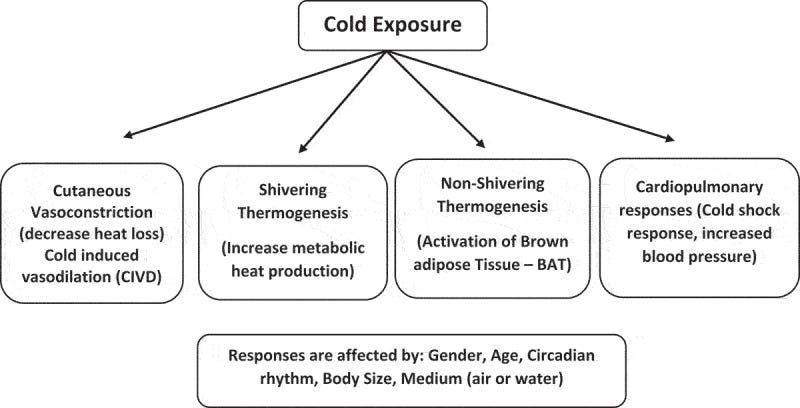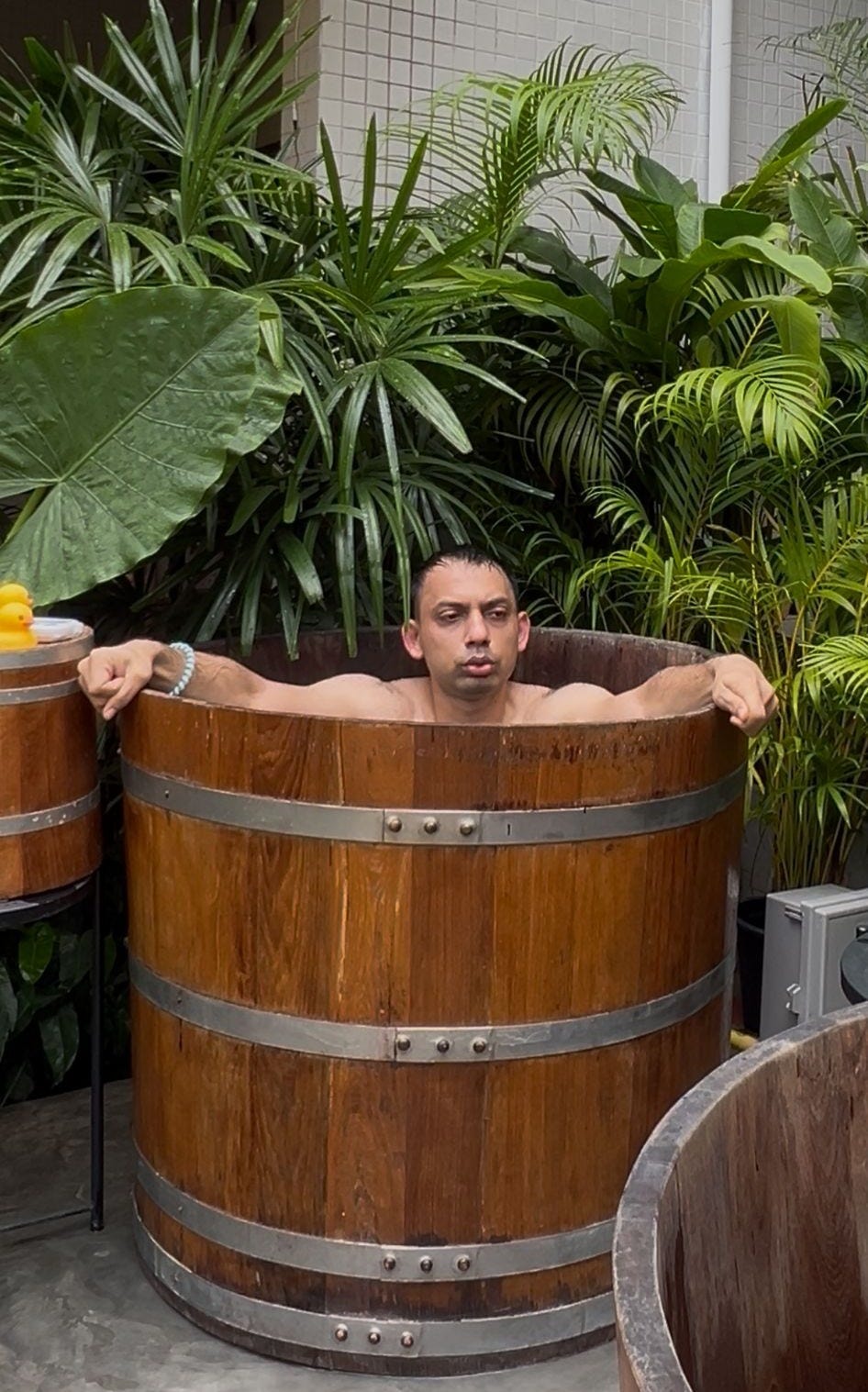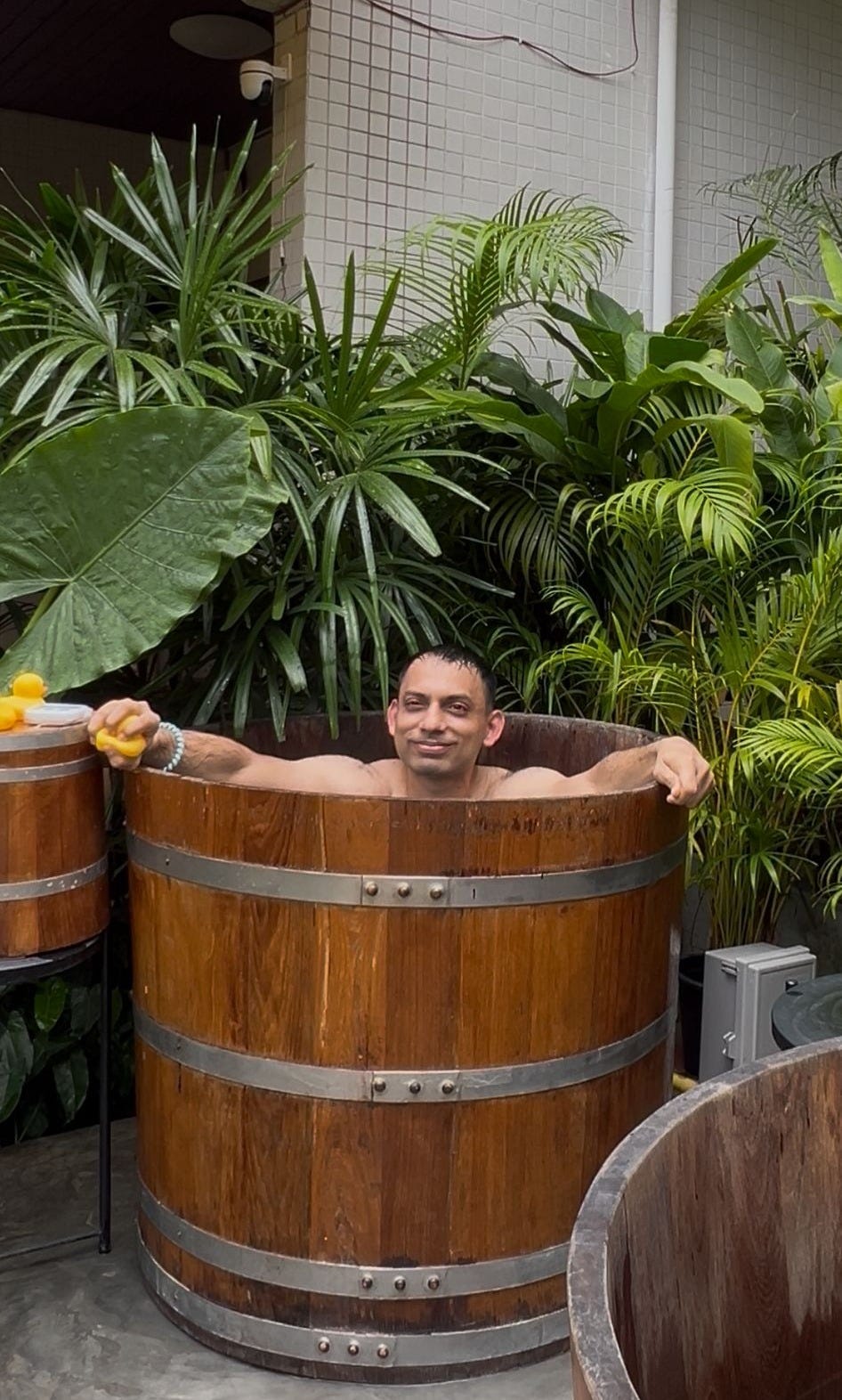Why I Finally Tried Cold Plunge ❄️🛁
Cold plunging is everywhere — from athletes to founders chasing recovery and focus. Here’s what happened after my first plunge, what science says, and where to try it in Singapore (+ a free session)
If you're new here — hi, I'm Shantanu. I run a longevity-science health brand, Xandro Lab, based in Singapore. Most of my weeks are split between marketing, operations, product dev, and testing new health tools I never imagined I'd care about five years ago. Cold plunging is one of them.
I tried my first cold plunge after a brutal HYROX race in Bangkok. My legs were dead, and my brain was fried. I’d heard enough people talk about “icing the inflammation” — so I finally gave in.
But the hardest part wasn’t the cold. It was taking off my shirt and stepping into a tub of ice in front of strangers. I was nervous — not about the water, but about being seen.
For months, that hesitation (my hairy chest, my back, my fear of posting the video online) had kept me from trying. I worried what people might say — and when I finally uploaded it, the mix of trolling and body-shaming confirmed that fear.
But I did it anyway. And I felt better — so much better, in fact, that I spent the next few weeks diving deep into the research.
Because cold plunging isn’t about looking good in a tub. It’s about bouncing back faster — mentally and physically — so you can keep showing up the next day.
Today, we’ll cover:
Why cold plunge is more than just a trend
What actually happened after my first plunge (post-HYROX)
What the science says about recovery, metabolism, and mental sharpness
How cold plunging fits into a high-performance lifestyle (with dos and don’ts)
Where to try it in Singapore — and how to get a free session
Bonus: Key recovery metrics to track
Note: This article is part of a 3-part series on recovery tools:
Cold Plunge for recovery
Sauna for longevity
Contrast Therapy as the best of both worlds?
1. Recovery is the Foundation of High Performance
Whether you're training for a race or building a business, how you recover affects how well you perform. Yet people think recovery is passive. Sleep. Stretch. Foam Rollers. Maybe a massage.
Cold plunge flips that. It's fast, physiological, and backed by real science.
A 2025 network meta-analysis encompassing 55 randomized controlled trials found that medium-duration (10–15 minutes) cold water immersion at 11–15°C significantly reduced delayed onset muscle soreness (DOMS) and improved recovery markers such as creatine kinase (CK) levels and jump performance. (Frontiers in Physiology, 2025)
Why? Cold exposure causes vasoconstriction, which reduces swelling, flushes out lactate, and triggers an anti-inflammatory response.
In other words: you don’t just feel better — you actually recover faster.
And I felt it myself. Two days after my HYROX race, I felt completely normal. No soreness. No aching legs when I turned in bed. No laughing involuntarily in my sleep from the pain (yes, that’s happened before). I even restarted strength training right after — no break was needed.
Imagine the power that gives your body — to recover fast and stay consistent without crashing.
2. What Research Really Says About Cold Plunging
A recent 2025 network meta-analysis of 55 randomized trials published in Frontiers in Physiology evaluated cold water immersion (CWI) protocols by temperature and duration. It found:
Best for recovery markers like creatine kinase (CK) and neuromuscular performance (JUMP): 5–10°C water for 10–15 minutes showed the greatest improvements.
(Wang et al., 2025)Best for soreness (DOMS): Slightly warmer immersion at 11–15°C for 10–15 minutes had the greatest impact. This range may be more tolerable yet still highly effective.
Colder isn't always better: Zero or near-freezing temperatures aren’t proven to be more beneficial and may increase discomfort, reducing long-term adherence. Researchers caution that extreme cold may deter consistency or lead to adverse effects without additional benefit.
No clear additional benefit below 5°C: None of the major meta-analyses (including the 2023 systematic review) support plunging at 0–3°C over 5–10°C, and discomfort increases dramatically at near-freezing levels without improving outcomes.
Mechanisms backed by science:
Vasoconstriction reduces inflammation.
Lowered nerve conduction helps with pain.
Cold activates brown adipose tissue and improves insulin sensitivity over time (based on animal and thermogenesis studies like Racinais et al., 2023).

But you don’t just bounce back physically. You feel sharper, calmer, and more focused after.
3. Mental Benefits: Calm, Clarity, and Focus
Cold plunging isn’t just about sore muscles — it’s one of the fastest ways I’ve found to reset my mental state after a high-output day.
After long hours of work or intense training — like my HYROX race — I sometimes hit a wall. Not tired enough to sleep, not sharp enough to work. That wired-but-foggy state where your brain is running but not landing.
Cold exposure snaps you out of that.
Here’s what the science says:
Norepinephrine levels spike dramatically during cold exposure — up to 530% after 14°C immersion for one hour (Huttunen et al., 2000). Even short plunges (~2–3 minutes) are shown to cause significant increases.
» This surge improves alertness, vigilance, and focus almost immediately.
The same study showed a 250% increase in dopamine, the neurotransmitter tied to motivation, mood, and executive function.
» You feel more driven and less anxious — the sweet spot for performance.
Repeated exposure to cold also trains your stress response. It mimics hormetic stress — small, controlled doses of discomfort that teach your body to adapt.
» The result: you stay calmer under pressure, both in the ice and in daily life.
Many people prefer to cold plunge in the morning — and for good reason. It delivers an instant norepinephrine and dopamine surge, sharpens focus, and sets a resilient tone for the day. It’s one of the most reliable ways to switch on both body and brain, fast.
4. But There’s a Catch: Timing Matters
Cold plunging right after strength training might not always be the best move.
Several studies, including a landmark paper by Roberts et al. (2015) in Journal of Physiology, found that cold water immersion blunted hypertrophy and strength gains when used immediately after resistance training (link).
Why? Cold reduces inflammation — which is great for soreness, but not ideal to build muscle (since inflammation signals the body to grow).
So here’s the protocol:
Post-cardio or hybrid training (like HYROX)? Use cold plunge within 30 minutes.
Post-heavy lifting? Wait at least 1–2 hours before plunging.
5. The 11-Minute Rule — and What Temperature Is Too Cold?
You don’t need to suffer endlessly to get results.
A 2021 review suggested that 11 minutes per week of cold exposure, spread over 2–4 sessions, is enough to drive most benefits — recovery, mental boost, and metabolic effects (Andrew Huberman, 2021).
The sweet spot:
Temperature: 10–15°C (50–59°F)
Duration: 2–5 minutes per session
Frequency: 2–3x/week
Here’s the twist: colder isn’t always better. While 0–5°C plunges are intense (and very viral), studies show that even at 14°C, your body activates brown fat, increases noradrenaline, and triggers metabolic responses. One trial showed improvements in insulin sensitivity and brown fat activation from just 2 hours/day at 14°C over 6 weeks (Hanssen et al., 2015).
If you go into 0–3°C water, the same mechanisms apply — but the risk of vasoconstriction, discomfort, or even hypothermic stress rises.
In short: 10–15°C is enough. If you like colder, do it — but don’t think you’re underachieving if you stay at 12°C.
6. Where to Try Cold Plunge in Singapore (And a Free Invite)
Singapore doesn’t have a strong sauna culture, but the cold plunge scene is growing fast. Here are a few spots I recommend:
The Ice Bath Club: Dedicated cold exposure space, great for beginners and experts. Andrew has been building a great community space, with coffee, food and space for kids to hangout. They have 3 centres now - River Valley, East Coast, Tanjong Pagar.
Cold Plunge SG: Functional setup on a CBD rooftop. Free trial available. Provides sunrise yoga, magnesium bath, breathwork and sound bath.
Solars Reformative: Primarily a Pilates studio, they have added cold plunge for recovery. I am trying their space in mid June. (may update this section with details)
Also hearing that a new longevity clinic at Park Hyatt is under development — might be the first luxury spot to combine cold therapy with full diagnostics.
Want to try it for free? I'm offering limited trial sessions to readers. Just reply to this blog email or DM me on Instagram (@shan.kr) and I’ll sort it out.
Also: If you're uncomfortable being shirtless, wear a quick-dry top. Seriously. Even people who look fit struggle with body confidence.
Note on Gender and Cold Plunge:
Most of the current research on cold plunge — especially related to thermogenesis and brown fat activation — has been conducted on men. Some women may experience increased discomfort due to hormonal or thermoregulatory differences, and research hasn’t fully caught up yet. If you’re trying this for the first time, start slow, and track how your body responds.
Bonus: Recovery Metrics That Matter
If you're investing in recovery tools like cold plunge, it helps to know what to track. Here are key metrics to watch:
DOMS (Delayed Onset Muscle Soreness): Subjective soreness typically 24–72 hours post-workout. Cold plunges help reduce this significantly.
Creatine Kinase (CK): Blood marker for muscle damage. High after strenuous workouts. Lower levels post-plunge indicate faster recovery.
Heart Rate Variability (HRV): Higher HRV = better nervous system recovery and resilience. Cold exposure can help improve baseline HRV over time.
Resting Heart Rate (RHR): A lower RHR over time indicates better recovery and cardiovascular health.
Lactate Clearance: The body’s ability to remove lactic acid after exercise. Cold plunging accelerates this, improving muscle recovery.
CRP (C-Reactive Protein): Inflammation marker in blood. Useful to track chronic inflammation levels.
You can track some of these via wearables (like WHOOP, Oura) and others through occasional blood tests or performance logs. Use them to measure what matters.
Final Thoughts: It Was Never About the Ice
What I feared most wasn’t the cold. It was being seen. But the bigger fear was staying stuck in patterns of poor recovery and burnout.
Cold plunging is now part of my recovery stack — not because it's trendy, but because it works. It helps me reset faster, so I can show up again the next day.
And if you're chasing high-performance health — in the gym, in your business, or just in life — maybe it's time you took the plunge too.
If this helped you, share it with someone who's curious about recovery tools or exploring cold plunge for the first time. I’m keeping all three parts of this series free to read — no paywalls, just honest tools for better living.
Next up: Part 2 – The Sauna Effect Why heat is the other half of the recovery story — and how it can help you live longer, not just feel better.
👋 Thanks for reading
If you made it this far — thank you. This wasn’t just a story about ice baths. It’s about doing hard things that actually help. Things that make us sharper, calmer, and more consistent — whether we’re chasing athletic goals, building a business, or simply trying to feel better in our bodies.
Cold plunging isn’t a silver bullet. But it’s a powerful tool — and one I wish I’d tried earlier.
If you found this post useful, feel free to share it with a friend who’s curious about recovery or high-performance health. I’ll be sharing two more posts in this series — one on sauna, and another on contrast therapy. All three will be free to read.
Thanks for supporting Out of Singapore. Your time, attention, and replies always mean a lot.
Until next Sunday —
Shan
(I realised that in Chinese context, Shan is a feminine name 🤣 In my defense, my name is Shantanu)





